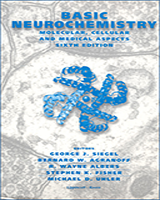By agreement with the publisher, this book is accessible by the search feature, but cannot be browsed.
NCBI Bookshelf. A service of the National Library of Medicine, National Institutes of Health.
Siegel GJ, Agranoff BW, Albers RW, et al., editors. Basic Neurochemistry: Molecular, Cellular and Medical Aspects. 6th edition. Philadelphia: Lippincott-Raven; 1999.

Basic Neurochemistry: Molecular, Cellular and Medical Aspects. 6th edition.
Show detailsThe cadherins (Fig. 7-4) are a superfamily of adhesion molecules which function in cell recognition [12,13], tissue morphogenesis and tumor suppression [14]. As a group, the cadherins are Ca2+-dependent adhesion molecules, and within the group, the classic cadherins are the best studied. These include neural cadherin (N-cadherin), epithelial cadherin (E-cadherin), placental cadherin (P-cadherin) and retinal cadherin (R-cadherin). Although the classic cadherins were originally named for the tissue in which they were first found, their distributions are in no way limited to these tissues. Brain tissue expresses at least 20 [15,16], and possibly many more, individual cadherins which are used in differential neurite outgrowth, cell—cell interactions and “locking in” pre- and postsynaptic membranes at the synaptic junctional complex.

Figure 7-4
Basic cadherin structure. Two types of cadherins are present in the nervous system: the classic cadherins with five extracellular domains and the protocadherins with six extracellular domains. For the classic cadherins, the binding partners on the cytoplasmic (more...)
In general, the cadherins have a common primary structure in that they all contain an amino-terminal extracellular domain, a single transmembrane domain and a conserved carboxyl-terminal cytoplasmic region, which is responsible for interactions with signaling pathways and with cytoplasmic and cytoskeletal proteins. The extracellular domain can be divided into five homologous regions, referred to as extracellular domains 1 through 5 (EC1— EC5). All of the extracellular domains are highly homologous to one another, and between the extracellular domains, Ca2+ articulates with binding sites and serves to rigidify the extracellular domain into a rod-like conformation.
The classic cadherins are homophilic adhesion molecules
That is, E-cadherin expressed on one cell surface binds to E-cadherin expressed on an apposed cell surface, N-cadherin binds to N, P to P and so forth. This is particularly true of E-cadherins. It was originally thought that all cadherins would behave completely homophilically, but it is now clear that, for example, N-cadherin can bind to R-cadherin, although perhaps more weakly than it would to N-cadherin. A crystal structure-based model [17] for a cadherin “adhesion zipper” has been presented (Fig. 7-5). The model postulates that in addition to the broad adhesive interface in EC1, which interacts with a partner adhesive interface protruding from the opposite cell bilayer, there is also a strand dimer formed by two identical cadherin molecules protruding from the same surface. This strand dimer orients the adhesive interfaces in the two strands such that they can interact with identical dimers on the opposite membrane surface, thus creating a linear zipper of tightly adherent cadherin molecules. The strand dimer itself is mediated by a tryptophan in position 2 in the mature classic cadherin molecule. Interestingly, this tryptophan, which is proposed to fit into a hydrophobic pocket on the partner strand, is found in the classic cadherins in the same position. The implications of the existence of the strand dimer are several. First, the cadherin strand dimer, whose formation produces cadherin clustering and concentration in a particular region of plasma membrane, is probably likely to be in a very stable conformational state, which allows for the maintenance of adherens junctions in epithelial cells and, perhaps, the synaptic junctions in the CNS [18,19]. Secondly, it is possible that on a given cell surface which expresses one or more classic cadherins, a monomer (nonadhesive)/dimer (very adhesive) dynamic equilibrium exists, which can be altered as the cell needs more or less adhesion.

Figure 7-5
Cadherins may form “adhesion zippers” to mediate cell adhesion. A globular model of the adhesion zipper is presented, illustrating the strand dimer postulated to exist between two cadherin molecules emanating from the same cell surface. (more...)
The first cadherin to be expressed in the nervous system is N-cadherin
This molecule appears around the time the neural tube closes [20]. As the neural tube expands and develops, a variety of cadherins can be detected in cell bodies, outgrowing neurites and synaptic endings. Many adhesion/recognition molecules have been implicated in guiding axons to their appropriate targets. Once the target axon has arrived in the vicinity of its ultimate destination, it has been suggested [21,22] that expression of identical cadherin molecules on both pre- and postsynaptic membranes ultimately links up and locks in these membranes to the synaptic junctional complex. According to this proposed mechanism, neurons in the brain would utilize the same mechanisms to produce pre- and postsynaptic membrane adhesion as do other cells in forming junctions, such as the cadherin-based mechanisms of the epithelial adherens junction. In the brain, neural transmitter release mechanisms, neurotransmitter receptors, second-messenger systems and other uniquely synaptic elements are superimposed on this adhesive scaffold. These complex elements expand the function of this “neural adherens junction.”
- The Cadherin Family - Basic NeurochemistryThe Cadherin Family - Basic Neurochemistry
- LOC17893806 [Capsella rubella]LOC17893806 [Capsella rubella]Gene ID:17893806Gene
Your browsing activity is empty.
Activity recording is turned off.
See more...